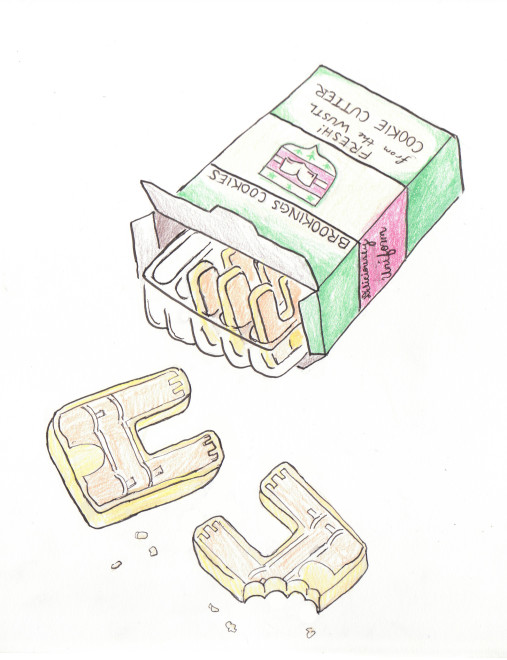Wash U’s Sore Thumb

I have always been drawn towards Eliot Hall and I frequently study there. The building’s lack of Wi-Fi prevents me from engaging in any of the innumerable cyber amusements that impede productivity. Its drafty rooms keep me from dozing off.
Perhaps my draw to the building is similar to Guy de Maupassant’s attraction to the Eiffel Tower. The French writer dined in the tower’s restaurant every day because it was the only place in Paris where he could avoid catching a glimpse of the one thousand foot structure.
To put it bluntly, I find Eliot Hall ugly. It is for this reason, however, that I refuse to join the chorus of students rejoicing in the University’s announcement that it will bulldoze the building this summer.
More Iron Curtain than Ivory Tower, the building was constructed in 1974 and reflects the ideals of Brutalism, a modernist architectural style noted for its concrete exoskeletons. Eliot sticks out amongst the neo-gothic buildings that dot the University’s Danforth Campus. Its incongruence certainly played a factor in the University’s decision to demolish it.
Wash U is very particular about and protective of its brand, as evidenced by its recent legal skirmishes with student bloggers over the utilization of various permutations of “Washington University.” Their self-consciousness extends to the architecture of campus.
The built environment is representative of how we as humans conceive of and value space. It is an exercise in expression, but also in instruction. The buildings around us significantly shape the way we think. The University is quite aware that its campus generates impressions in those who visit.
Like any good marketer, the University capitalizes upon nearly every opportunity to shape the minds, subliminally or consciously, of its customers.
Most of the Danforth Campus reflects the collegiate gothic architecture of the original Brookings Quadrangle. Buildings are constructed in a kind of reverse Botox: architectural wrinkles such as arches, grotesques, gargoyles, and spires are added to invoke the setting of an “elite” college campus we are so accustomed to seeing in the movies. Images of Oxford and Cambridge, tweed jackets with padded elbows, and heavy books flood our consciousness when we walk through the Danforth Campus.
The bell chime recordings at Graham Chapel are the University’s form of collegiate gothic Muzak: every fifteen minutes, students and visitors alike are lulled with yet another reminder that they are, in fact, on an elite institution’s campus.
Other architectural facets contribute to the University’s marketing narrative. Simon Hall is designed in a Prairie School style that captures the innovative spirit of the American frontier—and also, the University suggests, that of its business students.
The narrative works. A perusal of Washington University’s page on College Confidential, a college admissions forum, reveals that, for many prospective students, the school’s picturesque campus seems as much of a reason to attend as its rigorous academics. We become intoxicated with the buildings, which gleam like supermarket displays, waiting to be purchased.
Nothing is inherently wrong with the visceral attraction to campus aesthetics. It is what we see when we first visit a school. Unlike an academic department’s quality, the architecture of a campus is so apparent, so real.
Problems arise, however, when the authenticity is manufactured, when form does not mean function. What I mean by this is illustrated by the University’s expressed intention to erect a fence in the North Side residential area along Forest Park Parkway. In a November 17 Student Life article, Brian Newman, project manager for the installation, presented aesthetics as one of the reasons to construct the fence: “This is the first part of our campus [people] see when they come in from the airport. We want to present an attractive face to visitors, and this is an easy way we can do that.”
I have heard of very few walls described as “attractive.” Why is aesthetic appeal so important for this wall? It is, as Newman states, just as much for the visitors as it is for the safety of residents. It is off-campus locations, and not the North Side, that have been the source of safety concerns in the past few years. A gate that is accessible with a University ID will do nothing to stop students from crossing in the middle of the street. Regardless, the image of safety must be sold to potential customers.
We see other conflicts between form and function in the University’s recent addition to its collection of collegiate gothic buildings. Unlike the stone frames of Brookings Quadrangle, buildings such as Seigle Hall and Green Hall are built of reinforced concrete covered with only a thin veneer of granite and limestone. Their similitude with their gothic forefathers only goes skin-deep. One could interpret such a structure, gothic on the outside and steel on the inside, as representative of the power dynamic of Wash U: industrialists wearing academicians’ cloaks.
The point of my argument is not to brew conspiracy theories or deride the corporate influence on universities. Industry support for our university provides exceptional opportunities for students. My question is rather how much we challenge the marketing ploys that the University presents to us and our future schoolmates. Do we look beyond the appearances? Do we accept without question the college experience that the University sells us or do we actively create our own?
A college environment is a unique place where students can shed social norms and challenge status quos. The most important lessons we learn here are not those that please us. Rather, it is in the ideas which cause us discomfort—and even upset us—that we find opportunities for growth.
As college students, we overcome the temptation to ignore complicating evidence in our papers. We refuse to caricature our ideas or other people. We learn to grapple with contradiction. Do we do the same with our campus environment?
The Danforth campus will soon erase the building that confounds our convenient notions of a college experience. Should we really be so pleased?